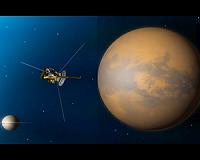 |
Tucson AZ (SPX) Oct 11, 2010 Simulating possible chemical processes in the atmosphere of Titan, Saturn's largest moon, an international team including University of Arizona graduate student Sarah Horst and Professor Roger Yelle demonstrated the synthesis of complex organic compounds, such as amino acids and nucleotide bases, which are the basic building blocks of life on Earth. The molecules discovered include the five nucleotide bases used by life on Earth (cytosine, adenine, thymine, guanine and uracil) and the two smallest amino acids, glycine and alanine. The intense radiation that hits the top of Titan's thick atmosphere is capable of breaking apart even very stable molecules. The international team wanted to understand what happens as these molecules are broken apart in the atmosphere. Using radio-frequency radiation as an energy source, Horst's collaborators created cold plasma consisting of nitrogen, methane and carbon monoxide in a reaction chamber. The experiment was the first to produce amino acids and nucleotide bases in an atmosphere simulation experiment without the use of liquid water. "We can do this entirely in an atmosphere," Horst said. "We don't need liquid water, we don't need a surface. We show that it is possible to make very complex molecules in the outer parts of an atmosphere." The results not only suggest that Titan's ionosphere could be a reservoir of prebiotic molecules that could serve as the springboard to life, but may offer a new perspective on the emergence of life on Earth as well: Instead of a primordial soup, the first ingredients of life on our planet may have formed from a primordial haze high in Earth's atmosphere. Moreover, the results show that it may be possible to study these processes in a planetary environment, particularly in the atmosphere of Saturn's moon Titan to gain a deeper understanding of this chemistry.
Share This Article With Planet Earth
Related Links University of Arizona Explore The Ring World of Saturn and her moons Jupiter and its Moons The million outer planets of a star called Sol News Flash at Mercury
 Cassini Gazes At Veiled Titan
Cassini Gazes At Veiled TitanPasadena CA (JPL) Sep 24, 2010 NASA's Cassini spacecraft will swing high over Saturn's moon Titan on Friday, Sept. 24, taking a long, sustained look at the hazy moon. At closest approach, Cassini will fly within 8,175 kilometers (5,080 miles) above the hazy moon's surface. This flyby is the first in a series of high-altitude Titan flybys for Cassini over the next year and a half. Cassini's composite infrared spect ... read more |
|
| The content herein, unless otherwise known to be public domain, are Copyright 1995-2010 - SpaceDaily. AFP and UPI Wire Stories are copyright Agence France-Presse and United Press International. ESA Portal Reports are copyright European Space Agency. All NASA sourced material is public domain. Additional copyrights may apply in whole or part to other bona fide parties. Advertising does not imply endorsement,agreement or approval of any opinions, statements or information provided by SpaceDaily on any Web page published or hosted by SpaceDaily. Privacy Statement |